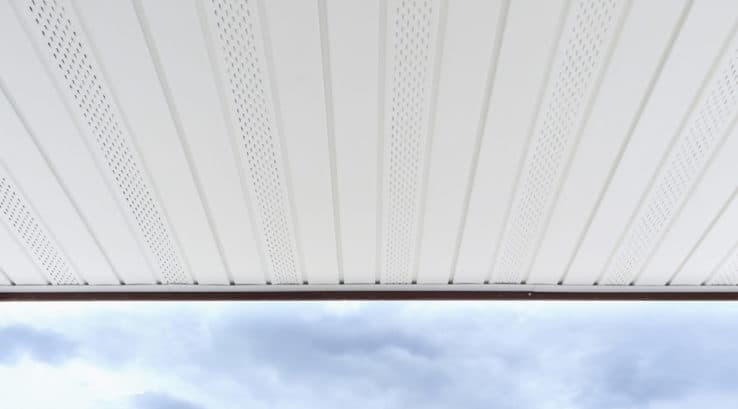If a roof had an underbelly, soffit would be it.
Soffit comes from the Latin word suffixus meaning fixed underneath which perfectly describes where a soffit is located on your home.
It’s not made to stand out or be flashy, but exterior soffit has its role nevertheless.
Where is soffit?
Soffit is the material between the roof’s eaves where the fascia and gutters are placed to the wall. Roofs that do not have overhangs do not have soffits.
Stand just outside your front door and look up. Do you have what looks like your home’s siding that veers out from the facade of your home? You’ve found your home’s soffit.
What is a soffit board?
How Much Does it Cost to Replace Soffit?
The price of fitting soffit is dependant on many factors.
- The depth of the home’s overhang, and the logistics of installation.
- The overall size of the building and its intricacies.
- The materials chosen.
- The offers around at the time.
While it is possible to compare the cost of materials, to summarize the price of an installation is not practical unless a similar project has already been installed.
Why does my home need soffit?
Soffit acts as a passive ventilation unit for your attic. It keeps warm moisture in the air from entering the attic air and condensing and creating mold.
Before soffit became a popular method of circulating air though a roof area, homes used gable vents or a hood vent to create air flow. The problem is they didn’t circulate all the air, just the air in specific locations and mold would grow in the insulation where it didn’t circulate.
Soffit outlining the roofline allows for continuous ventilation and is one of the most effective ways to ventilate into the attic. Air from the soffit cycles to the vents to draw heat and moisture away from the house. Moisture is mold’s breading ground and the cause of roof rot and poor air quality.
The soffit also helps keep pests from slipping into your home through the roofline or gutters and nesting in your attic. In addition to failing to pay rent, animals can cause damage to your roof and things like your electrical systems as well as contribute to unhealthy air quality.
What type of soffit is right for my home?
At Thompson Creek often our customers choose to replace a roof, gutters, soffit and trim at the same time for the best result. This enables our Thompson Creek roofing experts to make sure your whole roofing system is working together to maximize the life cycle and health of the roof. There are several signs pointing to a failing roof including, high energy bills, ceiling stains, shingle wear and sagging.
While soffit comes in wood and aluminum, they are most commonly made of vinyl for durability.
Soffit can be non-vented or vented to allow for maximum roof ventilation. Non-vented or continuous soffit works best when your roof has narrow eaves or if you need to ventilate a large amount of attic space. Vented soffit panels are good with a wider eave and a smaller amount of attic space because they have smaller vents between solid panels.
What is the upkeep on a soffit?
Vinyl soffit need little maintenance so long as they are installed correctly.
Here’s what you can do to prolong the life of your roofing system:
- keep gutters clean and free of debris
- size gutters correctly for the roof size
- keep soffit well-sealed and caulked
- check soffit for bees, hornets and wasp nests
- make sure your attic fan is in working order and cleaned
- remove any mildew on soffits using a soft brush and a solution of bleach and water.
Soffits can both complement the architecture and look of your home while serving to help keep your whole roofing system working properly.
Why is Soffit Vented?
The purpose of venting soffits is to evenly distribute an airflow throughout the roof space to ensure the roof remains dry and free from mold.
Exterior surfaces of the roof are exposed to extremes of cold and heat throughout the year, and this issue is compounded by the need to warm a home during Winter and yet stay cool in the Summer.
During Winter, a home is heated and as hot air rises, it travels to the roof space, the exterior of which is being pounded by cold rain or snow.
The extremes meet, and without some form of remedy will cause condensation.
Evenly venting the roof space will prevent damp patches and ultimately the roof from rotting or damage.
Do I Need Vented Soffits?
Soffit vents are not the only method used for the intake of air.
If your roof has other means of venting and an adequate supply of airflow, there’s no need to add more.
There are also roofs known as ‘hot roofs’ where the rafter bays are insulated and sealed.
These sort of more modern roofs have their advantages and drawbacks and our experts can advise about the suitability of soffit fitting.
What are Eaves?
Eaves are the ends of the roof that overhang the exterior of a wall and project over a building.
Their main purpose is to divert water clear of the construction, but they can also be included into the architecture to enhance the design of a structure.
There are older homes which are built with open eaves; where the ends of the roof beams are prominent and purposely left without soffit.
Older architectural design experimented to ensure airflow and to inhibit mold growth and prevent moisture in the roof.
Often, you may find the ends of the roof joists protruding from under the shingles or tiles but the gap left between the joists are enclosed: This can also be termed as ‘closed eave’.
Both of these types of eaves are repairable, but soffits and fascia board can also be installed to create closed eaves to create a new look to the home or structure.
The depth and sizes of eaves vary greatly depending on the roof design.
At Thompson Creek, we operate a free, no obligation survey which is necessary to justify the overall cost.
What is Fascia?
If ‘soffit’ is the horizontal base area that covers the eaves, ‘fascia’ is the vertical.
Fascia board is placed on the ends of the eave rafters and under the roof shingle or tile.
Vinyl fascia is generally not self supporting and is fixed with stainless steel nails to wooden boards which are pressure treated to prolong their lifespan.
Along with pressure treated timber, fascia can be utilized to support the ends of tiles which protrude into the gutter, allowing rainwater to drop directly into the gutter down drainage pipes attached, and away from the building via drainage systems.
Vinyl fascia is especially resilient to the changing weather, and doesn’t need painting, saving time and money in maintenance.
Our expert roofing technicians at Thompson Creek use a specially designed roofing system that offer homeowners layers of protection. And your investment is protected by our Thompson Creek No-Hassle Warranty and Buyer Protection Guarantee. Call Thompson Creek at 888-696-7105 for a no-obligation quote today.





